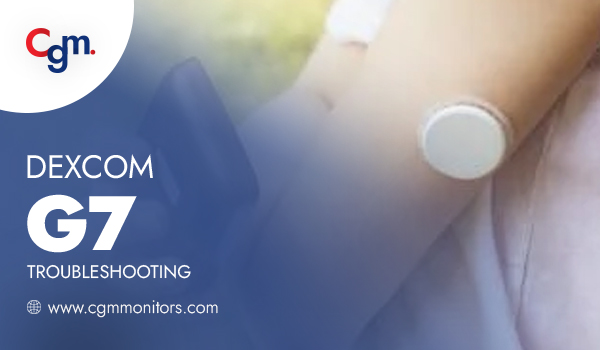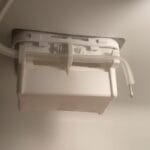For troubleshooting Dexcom G7 issues, first ensure the device is correctly charged and securely connected. Consult the user manual for specific error messages.
Navigating the world of continuous glucose monitoring (CGM) can be daunting, especially when you encounter problems with sophisticated devices like the Dexcom G7. This cutting-edge technology has transformed diabetes management, providing real-time glucose readings directly to your smartphone or dedicated receiver.
Yet, like all technology, it may occasionally run into issues. Understanding common troubleshooting steps can significantly enhance your experience, ensuring minimal disruption in glucose monitoring. Our guide aims to demystify the process, offering straightforward solutions to common problems. Whether it’s sensor errors, connectivity issues, or calibration discrepancies, we’ve got you covered. With a focus on keeping things simple and stress-free, we strive to empower users to manage their Dexcom G7 effectively, ensuring they can continue to rely on its critical health insights without unnecessary interruptions.
Introducing The Dexcom G7
The Dexcom G7 is the latest innovation in continuous glucose monitoring (CGM). Users across the globe anticipate its arrival. This cutting-edge device promises to make managing diabetes simpler and more precise. The G7 offers real-time glucose readings directly to your smart device. Its sleek design and user-friendly interface stand out. It is perfect for anyone seeking hassle-free glucose tracking.
Key Features And Upgrades
- Smaller Size: The G7 is 60% smaller than previous models.
- Faster Sensor Warm-up: It takes only 30 minutes to start.
- Enhanced Accuracy: Advanced algorithms ensure precise readings.
- Extended Wear: Each sensor lasts up to 10 days.
- Direct-to-Phone: No receiver needed for data transmission.
- Improved Alarms: Customizable alerts for glucose levels.
Transitioning From Older Models
Transitioning from older Dexcom models to the G7 is smooth. Users can expect familiar features with significant improvements. The G7 works with an updated, intuitive app. This app makes data sharing with caregivers easier. For those upgrading, old sensors won’t work with the G7. But the new sensor application is simplified for ease. The G7’s benefits make switching a positive step forward.

Credit: www.reddit.com
Initial Setup Challenges
Welcome to the guide on Dexcom G7 initial setup challenges. Setting up a new medical device can be tricky. Users might face issues. This section helps new users. Read on for solutions to common setup problems.
Activating The Sensor
Activating your Dexcom G7 sensor is key. Start by cleaning the application site. Make sure your skin is dry. Open the sensor package. Remove the sensor from its box. Peel off the adhesive backing. Place the sensor on your body. Press firmly around the adhesive. Your sensor is now active.
Mobile App And Receiver Pairing
To pair the mobile app and receiver, follow these steps:
- Download the Dexcom G7 app.
- Open the app on your smartphone.
- Select the ‘Settings’ option.
- Choose ‘Pair New Device’.
- Follow on-screen instructions.
- Confirm the pairing code matches.
- Wait for the confirmation message.
Patiently follow these steps for a successful pairing. Check your Bluetooth is on. Ensure the receiver is charged. This ensures smooth pairing with the app.
Common Sensor Issues
Navigating through Dexcom G7 sensor issues is crucial for users. Understanding common problems helps ensure continuous glucose monitoring. This section dives into typical sensor concerns and offers troubleshooting tips.
Sensor Adhesion Problems
Keeping the sensor securely attached is vital. Here are solutions:
- Use adhesive patches – They add an extra stickiness layer.
- Clean skin properly before applying the sensor. Alcohol wipes work well.
- Avoid lotions or oils near the site. They make skin slippery.
- Try a sensor guard for extra security.
Sensor Failure Alerts
Sensor failures can interrupt glucose monitoring. Here’s what to do:
- First, check sensor connection. Make sure it’s properly inserted.
- If the alert persists, restart your device. Sometimes it’s a simple glitch.
- Replace the sensor if problems continue. It might be defective.
- Contact Dexcom Support for further assistance. They’re there to help.
Connectivity Concerns
Many Dexcom G7 users face connectivity issues. These can disrupt glucose monitoring. Let’s troubleshoot common problems.
Bluetooth Pairing Difficulties
Bluetooth pairing is crucial for the Dexcom G7. It connects to your device. If it fails, follow these steps:
- Ensure Bluetooth is on in your device settings.
- Keep the Dexcom G7 close to your device.
- Check for obstructions that may block the signal.
- Restart both the Dexcom G7 and your device.
- Forget the device in Bluetooth settings and re-pair.
Still struggling? Your device’s manual can help.
Data Transmission Interruptions
Data interruptions mean missed glucose readings. They can be fixed:
- Check the Dexcom app for updates.
- Make sure your device has Internet access.
- Close other apps that might interfere.
- Turn off the device’s battery saver mode.
- Check the Dexcom G7 sensor and transmitter.
Consistent data flow is key for monitoring. These steps can restore it.
Accuracy And Calibration
The Dexcom G7 is renowned for its precision in glucose monitoring. Still, users may occasionally encounter inaccurate readings. Understanding how to address these inaccuracies is crucial for maintaining reliable data. Calibration plays a pivotal role in ensuring accuracy. Below are essential tips and solutions for dealing with inaccurate readings and calibration advice.
Dealing With Inaccurate Readings
Confirm the reading with a fingerstick blood glucose test if the Dexcom G7’s results seem off. Compare both values to assess the discrepancy. If the issue persists, consider these steps:
- Check sensor placement. Ensure it is secure and correctly positioned.
- Stay hydrated. Dehydration can affect glucose readings.
- Review medications. Some drugs may interfere with the sensor’s performance.
- Contact Dexcom support. They can assist with troubleshooting steps.
Calibration Tips
Calibration is key for the Dexcom G7 to function accurately. Here’s how to calibrate effectively:
- Wash and dry your hands before testing your blood glucose.
- Use a fresh lancet for a more accurate fingerstick reading.
- Enter the blood glucose value into the Dexcom app promptly.
- Calibrate when glucose levels are stable, not during rapid changes.
Remember, calibration is not daily. Follow Dexcom’s guidelines for when and how often to calibrate your device. A well-calibrated CGM delivers reliable data to manage your diabetes effectively.

Credit: cgmmonitors.com
Skin Reactions And Irritations
Many people use the Dexcom G7 to monitor their glucose levels. Sometimes, the device can cause skin reactions or irritations. Let’s learn how to spot and manage these issues.
Identifying Allergic Reactions
Some users may have an allergic reaction to the Dexcom G7. Signs include:
- Redness around the sensor site
- Swelling or bumps
- Itching or burning sensation
- Skin feels hot to touch
These reactions appear within a few hours to days after application.
Mitigation Strategies
To reduce skin reactions, try these tips:
- Use a barrier spray or cream before applying the sensor.
- Rotate the sensor site with each new application.
- Apply an over-patch to protect the area.
- If irritation persists, consult a doctor.
Remember, a clean and dry application site also helps.
Troubleshooting Alarms And Notifications
Continuous glucose monitoring systems like the Dexcom G7 are life-changing. They offer real-time glucose data, but sometimes users may face issues with alarms and notifications. Let’s troubleshoot and ensure the Dexcom G7 works smoothly.
Understanding Urgent Alerts
The Dexcom G7 provides urgent alerts for high and low blood sugar levels. These alerts require immediate attention. Users must acknowledge these alarms promptly to maintain safety.
- Low Glucose Alert: Check blood sugar and consume carbohydrates if needed.
- High Glucose Alert: Consider insulin or consult a doctor.
- Urgent Low Soon Alert: Act quickly to prevent a low sugar event.
Managing False Alarms
Sometimes, the Dexcom G7 might give false alarms. These can be stressful and annoying. Here’s how to manage them effectively.
| Issue | Solution |
|---|---|
| Unusual glucose readings | Calibrate the device as directed. |
| Repeated alerts | Check sensor placement and adhesion. |
| Signal loss | Ensure close proximity to the device. |
Battery And Charging Issues
Dexcom G7 users often encounter battery challenges. Proper care ensures longer battery life. This section covers common issues and fixes.
Extending Transmitter Battery Life
Maximize your Dexcom G7 transmitter battery effectively. Here are some tips:
- Keep it clean: Wipe the transmitter with a dry cloth.
- Store properly: Place it in a cool, dry area when not in use.
- Avoid extremes: Keep away from heat and cold.
- Update software: Ensure the latest firmware is installed.
Troubleshooting Charging Problems
Is your Dexcom G7 not charging? Try these steps:
- Check the cable: Ensure it’s properly connected.
- Inspect the charger: Use the official charger only.
- Restart the device: Sometimes a simple reset helps.
- Contact support: Get professional help if needed.
Software Updates And Technical Support
Dexcom G7 users often experience smooth sailing with their CGM systems.
Yet, occasional software hiccups do occur.
Fear not!
The right support and updates can swiftly put things back on track.
Let’s delve into troubleshooting these tech challenges.
Navigating Software Glitches
Software glitches can be a real headache.
They can disrupt glucose monitoring routines.
But there’s a simple fix.
Regular software updates are the key.
- Check for updates in the app regularly.
- Enable automatic updates for convenience.
- Reboot your device after an update.
If issues persist after updating, a reset might help.
Follow these steps:
- Open the Dexcom app.
- Go to settings.
- Select ‘Device’.
- Tap ‘Reset Device’.
Still stuck?
Read on for when to seek further help.
When To Contact Customer Support
Sometimes, a glitch won’t budge.
That’s when Dexcom’s customer support steps in.
Reach out if:
| Issue | Action |
|---|---|
| Continuous errors | Contact support |
| App not syncing | Check FAQ or call |
| Sensor issues | Seek immediate help |
Dexcom’s team is ready to assist, 24/7.
Don’t hesitate to call or email them.
They are there to ensure your system works flawlessly.

Credit: www.dexcom.com
User Tips And Best Practices
Living with diabetes requires constant management. The Dexcom G7 makes tracking glucose levels easier. Even the most tech-savvy users might face challenges. This section shares user tips and best practices for the Dexcom G7. Users can avoid common issues and enhance their experience.
Community Advice
Users often share valuable insights based on personal experiences. These tips can help new users troubleshoot common issues:
- Charge the transmitter regularly to prevent disconnects.
- Keep the receiver close by for consistent data syncing.
- Check the app notifications for updates and alerts.
- Apply the sensor to a clean, dry area on the body.
Maximizing The G7 Experience
To get the most out of the Dexcom G7, follow these best practices:
- Review the manual for proper setup and usage.
- Use the Dexcom app to track trends over time.
- Calibrate the device as recommended for accuracy.
- Stay hydrated, as dehydration may affect readings.
- Reach out to Dexcom support when in doubt.
Remember to share your own experiences with the Dexcom community. Your insights could be invaluable to others.
Faqs Addressed
Welcome to our ‘FAQs Addressed’ section for Dexcom G7 users. Find answers to common concerns and expert advice here. Get insights and solutions for your Dexcom G7 issues.
Top User Concerns
Dexcom G7 users often face similar issues. We list top concerns to provide targeted help.
- Sensor adhesion problems
- Reading inaccuracies
- Bluetooth connectivity
- Smart device compatibility
- Alarm settings
Expert Answers
Our experts share their knowledge on troubleshooting Dexcom G7. Read these answers for quick fixes.
| Issue | Solution |
|---|---|
| Sensor Won’t Stick | Clean skin with alcohol wipes. Use an over-patch. |
| Inaccurate Readings | Hydrate well. Avoid pressure on the sensor. |
| Bluetooth Issues | Keep the device within 20 feet of the sensor. |
| App Compatibility | Update your smart device’s operating system. |
| Alarms Not Working | Check volume settings. Ensure alarms are on. |
Frequently Asked Questions
How To Resolve Dexcom G7 Sensor Errors?
Dexcom G7 sensor errors can often be resolved by restarting the sensor or checking the insertion site for issues. Ensure the transmitter is properly connected.
Can I Reconnect A Loose Dexcom G7 Transmitter?
Yes, a loose Dexcom G7 transmitter can be reconnected. Press firmly until you hear a click, indicating it’s securely in place.
What To Do If Dexcom G7 Doesn’t Calibrate?
If your Dexcom G7 doesn’t calibrate, wash your hands, retest your blood glucose, and enter the new value for recalibration through the app or receiver.
Why Is My Dexcom G7 Giving Inaccurate Readings?
Inaccurate readings may result from sensor placement, medications, or dehydration. Rehydrate, avoid applying pressure to the site, and consult the manual for medication interferences.
How To Troubleshoot Dexcom G7 Bluetooth Issues?
To troubleshoot Bluetooth issues, ensure your device is within range, restart the Bluetooth connection, and check for any interference from other electronic devices.
What To Do When Dexcom G7 Alarm Fails?
If the Dexcom G7 alarm fails, check your device’s volume and notification settings, replace the battery if needed, and ensure the app is running in the background.
Conclusion
Navigating Dexcom G7 issues doesn’t have to be daunting. With the right steps, you can often find quick fixes to common problems. Remember, consistent device maintenance and staying informed on updates will enhance your experience. For further support, Dexcom’s customer service is just a call away.
Keep your glucose monitoring on track with these troubleshooting tips.




